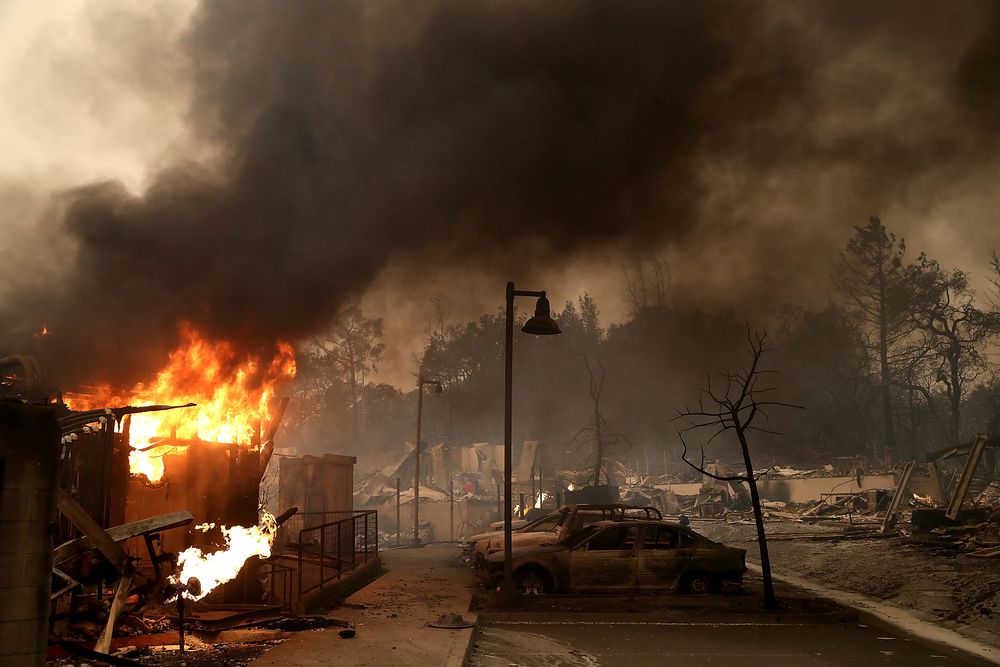
In the News
North Bay Wildfires: How Climate Change Made the Disaster Worse
-
Focus Areas
Environmental Health -
Issues
Climate Change, Wildfires & Extreme Heat -
Programs
Center for Climate Change and Health

Nobody can yet say for certain exactly what ignited the deadliest and most costly wildfire in California history on October 8.
But climate scientists do know why conditions were tailor-made for the swift-moving maelstrom that killed 42 people, burned 6,700 homes and buildings, and blanketed millions of people in toxic smoke: Hotter temperatures; drier, abundant fuel; and stronger winds.
What caused all that? The answer is simple, obvious, and predictable: climate change.
Forty years ago, the average length of “fire season” in the western United States was about 138 days—the start of summer to the first winter rainfalls sometime in October. Now, says LeRoy Westerling, a professor at UC Merced and co-director of the school’s Center for Climate Communication, fire season in the West—the arid West, a vast inhospitable expanse made habitable for the white man’s notion of civilization thanks only to the power and glory of irrigation—lasts 222 days.
“Fire season” is now another way to say “most of the year.”
This shift happened in our lifetimes. Since 1980, average global temperatures have escalated steadily and rapidly. Sixteen of the 17 warmest years on record have all come since 2001—and the world was noticeably hotter well before then. In that time, the areas burned by wildfires in the west have increased 390 percent—that is, “390 percent per decade, over that original baseline,” Westerling said during Tuesday’s conference call. The probability of grasslands igniting has also increased significantly, from a 0.5 to 0.75 percent chance to a probability of between 1 and 2 percent.
You probably knew most of this, but what you may not know are the full ramifications or what to do about it.
How exactly did climate change cause the North Bay fires?
“Cause” is too strong a word. Warmer temperatures created the conditions for a fire to be more likely and more severe—and will continue to do so.
First, heavy winter rains after years of drought created an abundance of vegetation. Climate change leads to erratic weather patterns that are also more severe. A long, hot, and dry summer rendered this tinder-dry vegetation into what fire scientists and campfire-builders call “fuel.” And more heat also means more wind—and it was the Diablo winds, more and more similar to the Santa Ana winds in Southern California, gusting at times to more than 70 miles per hour, that spread the North Bay fires so quickly.
“Heat is what drives the wind in the first place,” said Dr. Bill Stewart, a specialist at UC Berkeley’s Center for Forestry.
How bad is the smoke, really?
Really, really bad. Wildfire smoke “is associated in numerous studies with increased premature death,” asthma, chest pain, and other “breathing problems, even in healthy people,” said Dr. Linda Rudolph, a public-health expert and director of the Center for Climate Change and Health at the Public Health Institute in Oakland. And, as most of the Bay Area witnessed over the past week, wildfire smoke travels long distances.
All this to say that wildfires are absolutely a problem for every Californian—all 40 million of us.
Can this happen here? By “here,” I mean (Los Angeles, San Francisco, Oakland, Hayward, insert name of city)?
Yes, certainly. We know this because it’s already happened here.
In 1991, more than 20 people died when wind-fanned flames torched the Oakland Hills. The behavior of the North Bay fires is “very similar to the Oakland Hills fire,” said Westerling.
The main difference there is that fire started from a single source. In Santa Rosa and the North Bay, there were possibly as many as 20 “starts,” as high winds carried embers far ahead of the fire line and ignited trees and other abundant dry fuel.
“If we had the wine country fire, more than 100,000 acres, that would be from Richmond to Hayward,” Westerling added. “And that is possible. We have more grasslands in those areas.”
The Oakland Hills fire showed that “it is not inconceivable to have a very, very large fire [in a more densely-populated area] when you have many starts,” Westerling said.
How quickly is our climate changing, really?
Do you like San Diego? If so, great, because Northern California’s ecosystem will more closely resemble the Southern California city in the coming years.
The state is on a trend where temperatures resemble places “one or two counties to the south” every decade, said Stewart. “Northern California, as it dries out, is acting more like Southern California. Hot fire weather is becoming more and more common way into the fall.”
Read the full article in Curbed San Francisco.
See also:
California Wildfires Stoke Need to Concentrate on Climate Change, Public Health – The American Prospect
Originally published by Curbed San Francisco
More Updates
Work With Us
You change the world. We do the rest. Explore fiscal sponsorship at PHI.
Support Us
Together, we can accelerate our response to public health’s most critical issues.
Find Employment
Begin your career at the Public Health Institute.



